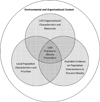Where is obesity prevention on the map?: distribution and predictors of local health department prevention activities in relation to county-level obesity prevalence in the United States
- PMID: 22836530
- PMCID: PMC3711616
- DOI: 10.1097/PHH.0b013e318221718c
Where is obesity prevention on the map?: distribution and predictors of local health department prevention activities in relation to county-level obesity prevalence in the United States
Abstract
Context: The system of local health departments (LHDs) in the United States has the potential to advance a locally oriented public health response in obesity control and reduce geographic disparities. However, the extent to which obesity prevention programs correspond to local obesity levels is unknown.
Objective: This study examines the extent to which LHDs across the United States have responded to local levels of obesity by examining the association between jurisdiction-level obesity prevalence and the existence of obesity prevention programs.
Design: Data on LHD organizational characteristics from the Profile Study of Local Health Departments and county-level estimates of obesity from the Behavioral Risk Factor Surveillance System were analyzed (n = 2300). Since local public health systems are nested within state infrastructure, multilevel models were used to examine the relationship between county-level obesity prevalence and LHD obesity prevention programming and to assess the impact of state-level clustering.
Setting: Two thousand three hundred local health department jurisdictions defined with respect to county boundaries.
Participants: Practitioners in local health departments who responded to the 2005 Profile Study of Local Health Departments.
Main outcome measures: Likelihood of having obesity prevention activities and association with area-level obesity prevalence.
Results: The existence of obesity prevention activities was not associated with the prevalence of obesity in the jurisdiction. A substantial portion of the variance in LHD activities was explained by state-level clustering.
Conclusions: This article identified a gap in the local public health response to the obesity epidemic and underscores the importance of multilevel modeling in examining predictors of LHD performance.
Figures
References
-
- Flegal KM, Carroll MD, Ogden CL, Johnson CL. Prevalence and trends in obesity among US adults, 1999–2000. JAMA. 2002 Oct 9;288(14):1723–1727. - PubMed
-
- Colditz GA, Stein C. Costs of obesity. In: Kumanyika S, Brownson RC, editors. Handbook of Obesity Prevention: A Resource for Health Professionals. New York: Springer; 2007. pp. 73–84.
-
- Marti A, Moreno-Aliaga MJ, Hebebrand J, Martinez JA. Genes, lifestyles and obesity. Int J Obes Relat Metab Disord. 2004 Nov;28(Suppl 3):S29–S36. - PubMed
Publication types
MeSH terms
Grants and funding
LinkOut - more resources
Full Text Sources
Medical
Miscellaneous



